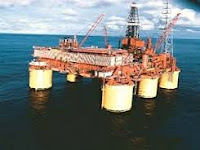Oil and Gas Drilling Rig
Jobs

Custom Search
Jack-up Rig: Jack-up rigs were conventionally used in shallow water since it was impractical to lower their legs in deeper offshore, but latest oil rigs such as the Tarzan-class rigs are now crossing those bounds.
These rigs are also
regarded as safer than several other types of transportable rigs, such as
drilling ships or drilling barges, because their deck amenities are elevated
from the water and hence less vulnerable to sea waves and rough weather.
Offshore oil reservoirs
that are in shallow water and are of small size which do not necessitate a
permanent platform, or for drilling exploratory wells, oil firms uses "Jack-up
Rig."
These rig’s floating
deck are towed into location by tug boats usually two or three tug boats, and
then lower its hold up legs down to the sea bottom, lifting up the rig above
the water level. The rig is then set up to different heights along its big
supporting legs.
This type of deep water
rigs are floating and semisubmersible, i.e., floating partially over the water
level while pumping oil out of deep wells. Some rig use wire rope to connect
with a stabilizing anchor, while others applies "dynamically
positioned," system using computer-synchronized thrusters to maintain them
in position.
Some rig use wire rope
to connect with a stabilizing anchor, while others applies "dynamically
positioned," system using computer-synchronized thrusters to maintain them
in position. These floating
production systems are used in water depths from 600 to 6,000 feet.
Because these rig’s
wellheads are positioned on the sea bed rather than a surface platform, as on
fixed-platform rigs, additional measures should be taken to prevent leakages.
An instrument on
deepwater wellheads called "blowout preventer" is used to prevent oil
from dripping. Usually, these types of rigs are amongst the most common types
of offshore rigs employed in the Gulf of Mexico.
Tension-leg platformor
or Seastar: Tension-leg platform type of rigs are deployed to drill further
than a mile, which are assembled by a floating surface construction embraced in
position by rigid, vertical ligaments attached to the sea bottom.
For drilling smaller
reservoirs in constricted regions, oil companies may as alternative use small
types of rigs famous as "Seastar," which permits for comparatively
low-priced production of small deepwater oil reserves that would or else be too
expensive to drill.
A typical spar platform
in the Gulf of Mexico is constructed by a 130-foot-wide cylinder, and about 90
percent of its whole structure is submerged.
Spar platform-: Spar
cylinders platform are utilised at depths up to 3,000 feet, but present
machinery can deepen this to about 10,000 feet, assembling them one of the
deepest-drilling types of offshore rigs.
Fixed platform: They can
drill about 1,500 feet below the sea level, but they are expensive to
construct, so they generally need a bigger oil finding to validate their
erection.
Compliant tower: The
compliant towers operate at larger depths than platform rigs, possibly up to
3,000 feet below the sea surface.

Custom Search















